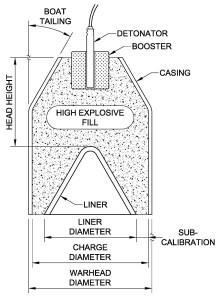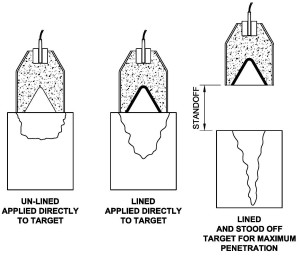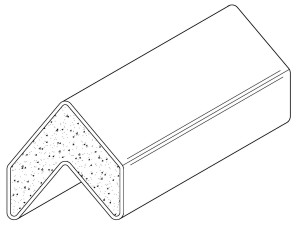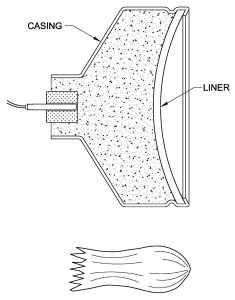Focused Charge Info
Focused charges are specialist devices that produce significantly more damage in a desired direction. We manufacture a range of different charge casings. This figure shows the typical construction of a focused charge.

Point Focal Charge
Effects: A point focal charge has a symmetrical hollow in the base. When detonated without a metallic liner, these charges will crater rock, concrete or spall steel. With a metallic liner these charges can easily penetrate steel, rock or concrete. These charges are sometimes referred to as beehive demolition charges.

Applications: Unlined point focal charges can be used for rock shattering or underwater for trenching or breaking up rock for anchor embedment.
Lined point focal charges are used widely in military ordnance to penetrate armour or concrete structures. We manufacture charges similar to a rocket propelled grenade round for evaluating armour or other protection measures. Lined focal charges can be used to “drill” a hole for filling with a bulk explosive for shattering rock or concrete where it may not be possible to use a drill rig. This includes underwater applications – removal of mooring structures or in remote / inaccessible locations where equipment has to be carried in. Small lined point focal charges can be used for explosive ordnance disposal (EOD) work. The charge is aimed at the munition from a short distance away, in case the device has been booby trapped. When fired, the jet from the liner will penetrate the casing and detonate the contents.
Lined point focal charges can be used to euthenase large stranded marine animals, such as whales, under the direction of suitably qualified personnel.
Linear Cutting Charge

Effects: Linear cutting charge produces a high velocity cutting “ribbon”, usually of copper.
Applications: Linear charge is primarily used for steel cutting for demolition purposes. Linear charge can be used to dispose of pressure vessels or cylinders containing dangerous goods. The vessels or cylinders can be buried in a neutralizing chemical and cut open remotely. Alternatively the cylinders can be cut open in air and the contents burnt out if they are volatile. Linear charge can also be used in explosive ordnance disposal (EOD) work – it can cut through to the outer case of the munition and ignite or detonate the contents.
We also design and manufacture cutting charges for use underwater such as chain cutting charges or pipe and casing cutting charges.
Hayrick Cutting Charge
Effects: Hayrick charges produce a linear cut but provide far greater penetration than linear charge.
Applications: Hayrick charges are typically a military demolition charge for rapidly weakening structures such as bridges. We custom design and build them for cutting large diameter wire and chain moorings or concrete reinforcing tendons. We have designed hayrick cutting charges for abandonment of offshore oil and gas facilities, such as floating production, storage and offloading (FPSO) tankers that can be used at the chain table.
Explosively Formed Projectile
Effects: An explosively formed projectile (EFP) produces a large, slow moving “slug” by deforming a relatively thick liner.

Applications: Explosively formed projectiles can be used to shatter rock or concrete from a greater distance than a point focal charge. They can also be used in EOD applications as the slower moving slug is less likely to initiate the explosive contents of device.
MORE INFORMATION
Contact Havoc Industries’ principal; Arran Gordon BEng (Hons)
Member of the International Society of Explosives Engineers
Mobile: + 61 (0) 419 512 911
Email: info@havoc.com.au
